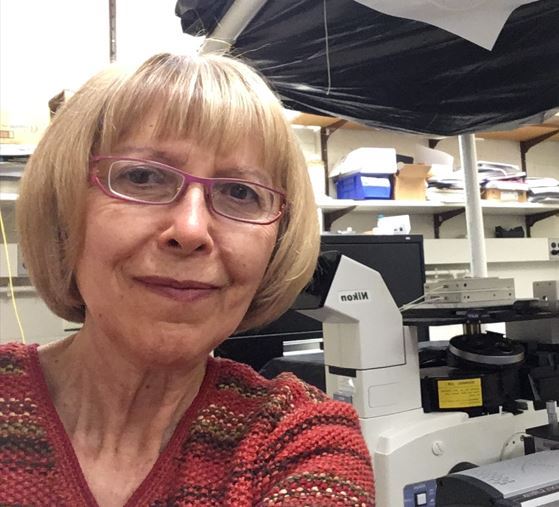Liquid crystals in nonlinear and quantum optics
Dr. Svetlana G. Lukishova, The Institute of Optics, University of Rochester

Abstract
Please join us in this special event honoring the memory of Stephen Jacobs and his long and distinguished career of contributions to the field of optics!
This review will highlight the main effects of using liquid crystals (LCs) in nonlinear optics [1-3], quantum optics, and nanophotonics [4, 5], starting from the first works on generation of harmonics and self-focusing of pulsed laser beams near the phase transition. The most important nonlinear optical properties of LCs are the giant orientational optical nonlinearity as well as thermooptical coefficients, which are more than an order of magnitude higher than the thermooptical coefficients of conventional liquids. The manifestations of giant optical nonlinearity in oriented layers of nematic LCs will be outlined. The dissolution of various dyes leads to many new unexpected non-thermal nonlinear effects with practical applications. LC glassy oligomers/polymers and polymer dispersed LC composites expand the range of applications for these materials.
In high-power nanosecond, picosecond and femtosecond laser interaction with LCs the following topics will be highlighted: (1) LC optics in high-power laser-fusion systems, high-laser-damage threshold of monomeric and polymeric LCs; (2) nonthermal unwinding of a cholesteric LC (CLC) helix by the field of a light wave [planar aligned CLCs act like mirrors (1-D photonic bandgap material) that selectively reflect light in a certain spectral region]; (3) low-threshold CLC microlasers; (4) enhancement of nonlinearity in the region of a gradient of a CLC mirror reflectivity (photonic band-edge); (5) nonlinear absorption and refraction, cumulative effects in thermal self-focusing; and (6) formation of ordered spatial patterns in beams without feedback in the presence of highly absorbing dyes.
The last part of this review will discuss the prospects for the use of LCs in nanophotonics (metamaterials, microcavities, and nanoplasmonics), in flat optics, and for shortening femtosecond laser pulses. From quantum optical applications, q-plates for creating beams with an orbital angular momentum, the generation of single (antibunched) photons with a definite polarization, modeling quantum mechanical tunneling phenomena will be considered as well as measurements in a Hong-Ou-Mandel interferometer of single photons’ transit times along a band-edge of CLC mirrors’ reflectivity. The prospects of patterned LCs will also be discussed.
References
- [1] S.D. Jacobs, K.L. Marshall, and A. Schmid, “Liquid crystals”, 509-577, Section 14, in Handbook of Laser Science and Technology, Supplement 2: Optical Materials, M.J. Weber, Ed., CRC Press, Boca Raton (1995).
- [2] I.C. Khoo, Liquid Crystals, John Wiley & Sons, Hoboken (2007).
- [3] S.G. Lukishova, "Nonlinear optical response of cyanobiphenyl liquid crystals to high-power, nanosecond laser radiation", J. Nonlinear Opt. Phys. & Mater. 9, 365–411 (2000).
- [4] S.G. Lukishova and L.J. Bissell, “Nanophotonic advances for room-temperature single-photon sources”, 103-178, in Quantum Photonics: Pioneering Advances and Emerging Applications, R.W. Boyd, S.G. Lukishova, V. Zadkov, Eds, Springer Series in Optical Sciences, Vol. 217, Springer NY (2019).
- [5] S.G. Lukishova, A.C. Liapis, L.J. Bissell, G.M. Gehring, and R.W. Boyd, “Single-photon experiments with liquid crystals for quantum science and quantum engineering applications”, Liquid Cryst. Rev 2, No. 2, 111–129 (2014).
About the speaker
Professor Svetlana G. Lukishova was born in Moscow. She received her BS/MS (with honors) and PhD degrees (1977) from the General and Applied Physics Department of the Moscow Institute of Physics and Technology (FizTech) working at the P.N. Lebedev Physical Institute of the Russian Academy of Sciences (RAS). Her senior project on theoretical astrophysics was made at a Nobel Prize winner V.L. Ginzburg’s theory department. Her PhD thesis was supervised by P.P. Pashinin and Nobel Prize winner A.M. Prokhorov and involved spatial beam-profile and temporal pulse-shape control in laser-fusion systems. After holding research positions at the I.V. Kurchatov Nuclear Power Institute, Troitsk branch TRINITI (Moscow Region), the Institute of Radioengineering and Electronics of the RAS (Moscow), and the Liquid Crystal Institute (Kent, OH), she joined the University of Rochester in 1999. In Russia she was awarded the International Science (G. Soros) Foundation a Long-Term Grant, the Russian Government and the Russian Foundation for Basic Research Grants for her work on nonlinear optics of liquid crystals. In addition to her research, she supervised and taught students at FizTech and served for the Soviet/Russian Committee of the International Scientific Radio Union URSI. She served at the Optica Award committees (C.E.K. Mees Medal and Max Born Award). She also served 6 years as a Topical/Associate editor of Optics Letters on nanophotonics, liquid crystals and nonlinear optics.
After 30-year-experience with high-power laser systems and interaction of laser radiation with matter she moved to quantum nanophotonics, that is currently her main research area in addition to liquid crystals. Awarded four NSF grants and a Wadsworth C. Sykes Faculty Engineering Award she created the Quantum Optics, Quantum Information and Nanooptics Teaching Laboratory facility and developed two undergraduate and one graduate courses on this facility. She also created and directs the University of Rochester undergraduate program on the Certificate in Nanoscience and Nanoengineering. In addition to her research, she is currently teaching three undergraduate and one graduate courses.
Professor Lukishova’s research interests include both optical material and optical radiation properties, in particular, quantum nanophotonics, liquid crystals, and nonlinear optics. She has approximately 250 publications including co-editing and chapters of two Springer books: “Self-focusing: Past and Present. Fundamentals and Prospects” (2009) and “Quantum Photonics: Pioneering Advances and Emerging Applications” (2019).
Pre-Talk Dinner with the Speaker
A pre-talk dinner with the speaker will be held at 5:15 pm at the King and I Cuisine of Thailand, 1455 East Henrietta Rd, Rochester, NY 14623. If you would like to attend, please contact the house committee by email to make reservations. Email: house@opticarochester.org
LLE COVI policy
Surgical, N-95 or KN-95 Masks are optional for fully vaccinated individuals in LLE facilities. Disinfectant wipes will be available for attendee use.